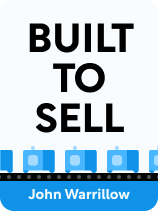

This article is an excerpt from the Shortform book guide to "Built to Sell" by John Warrillow. Shortform has the world's best summaries and analyses of books you should be reading.
Like this article? Sign up for a free trial here.
What is the book Built to Sell about? What are the main takeaways of the book?
In Built to Sell, John Warrillow teaches you how to build a business you can sell. To create such a company, he provides a step-by-step process any business owner can follow.
Read below for a brief Built to Sell book overview.
Built to Sell by John Warrillow
In the Built to Sell book, businessman John Warrillow provides advice on how to make your small business sellable. The best way to do this, according to Warrillow, is to build a business that can run on its own—a business that can function without you, the owner. Even if you don’t plan to sell your business anytime soon, or ever, it still benefits you to build a valuable company that can be sold to the highest bidder.
John Warrillow is an expert in small business and entrepreneurship, and he has first-hand experience selling a business. As a radio host, Warrillow has interviewed hundreds of entrepreneurs. His business, Warrillow and Co., was a major player in the small business world before being purchased in 2008. They produced detailed research papers on small businesses and organized conferences that help Fortune 500 companies reach smaller companies.
Built to Sell is presented as an extended, hypothetical story that takes you through the process of running and selling a profitable small business, but we’ll present this process without the story.
What Makes a Business Sellable
Warrillow claims that the main attribute that makes a business sellable is its ability to flourish without the owner. A business that doesn’t rely on the owner, or any other single employee, will look much more attractive to potential buyers.
Many small business owners become so intertwined with their company that the company can’t function without them. When customers are used to dealing with the owner, and employees can’t do their job without the owner present, it can be hard for the owner to leave for a week’s vacation, much less leave it altogether. No buyer will be willing to purchase a business so dependent on one person.
To build and sell a company that can run without you, Warrillow lays out a step-by-step process, which involves finding the right product or service to sell, generating a positive cash flow, and hiring and training the right employees and managers.
Step 1: Find Your Scalable Specialty
Warrillow claims the first step in building a sellable company is to determine which service or product to specialize in. Many small companies spread their efforts too thin over a variety of products or services. This may be good for business in the short-term, but it makes it much harder to grow as a company because you won’t have the time or resources to expand in several different areas simultaneously. Instead, find one product or service that you not only excel at, but that is scalable.
Step 2: Generate Positive Cash Flow
Once you’ve chosen your specialty, Warrillow says you next need to focus on generating positive cash flow. Positive cash flow means your business is bringing in more money than it’s spending, and it’s a key to creating sustainable growth and freeing up enough cash to implement the rest of Warrillow’s process.
Step 3: Hire the Right Salespeople
Now that you have cash on hand and a service you can provide without being personally involved, Warrillow recommends hiring a sales team. With a sales team, you can remove yourself from the process of selling the service or product.
Step 4: Put in Place a Team of Managers and Incentivize Them to Stay
Warrillow claims that if you want to sell your business, you next need to prove you have a capable management team that is likely to stay with the company after the sale. Your management team, whether it’s a single manager who knows the ins and outs of the business or several managers with a variety of expertise, should be able to oversee every aspect of the company without you and have the ability to deal with any potential issues.
Step 5: Find the Right Company To Help Sell Your Business
Once your company is in a good position to be sold, Warrillow claims you need to find a professional advisor to help with the sale. When searching for an advisor, there are two key aspects to consider: the size of the firm and their knowledge of your business specialty.
Step 6: Inform Your Managers
According to Warrillow, telling your managers you plan to sell the company can be a tricky and uncomfortable situation. If you own a small business, you’ve probably worked closely and built a relationship with your management team, and they may not be happy to hear you’re selling the business. The best time to tell them will vary depending on your situation, but Warrillow recommends letting them know once you find a potential buyer. The potential buyer will want to set up a meeting with you and your managers to get a feel for the company. Obviously, you don’t want your managers to be blindsided by this meeting.
Step 7: Accept An Offer
The final step in selling a business is to accept an offer. Warrillow recommends knowing exactly what you want from a deal. This will make the decision easier. For example, have a minimum amount of money you’ll accept up front, with any performance fees or add-ons seen as a special bonus. If most of your compensation is based on how the company performs in the future, you may be forced to continue working for the company to ensure you get a proper payout. Knowing exactly what you want will help you stand firm if your business broker pushes for you to accept a lower deal just so they can get paid and move on.

———End of Preview———
Like what you just read? Read the rest of the world's best book summary and analysis of John Warrillow's "Built to Sell" at Shortform.
Here's what you'll find in our full Built to Sell summary:
- A step-by-step process for building a business you can sell
- Why you should build a sellable business even if you don't intend to sell it
- How to manage the selling of your business and all the headaches that come with it






